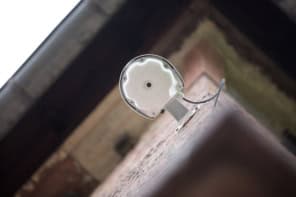This podcast takes you on the hunt for hidden chambers within a pyramid in Mexico – potentially the resting place for the leaders of a mysterious pre-Colombian civilization. Physics World journalists James Dacey and Matin Durrani were the final visitors to a particle-physics detector located in a tunnel beneath the Pyramid of the Sun at the settlement of Teotihuacan, 50 km north-east of Mexico City. For the past 15 years, physicists have been using this experiment to track the flux of natural radiation and build an image of the pyramid’s sealed inner structure
Archaeologists believe Teotihuacan was established in 100 BC before growing to become one of the largest settlements of ancient times and home to an estimated 125,000 people. The Teotihuacanos were contemporaries of the Mayans. But while it is clear that the Teotihuacanos were aware of the Mayans, very little else is known about this mysterious civilization. One of the big mysteries surrounds the city’s leaders – who were they and where were they buried? As the ancient Egyptians enshrined their Pharaohs in pyramids, perhaps the Teotihuacano leaders are hidden within the Pyramid of the Sun.
To answer this question, archaeologists turned to a group of physicists led by Arturo Menchaca Rocha of the National Autonomous University of Mexico (UNAM). Menchaca’s team has tried to peer inside the pyramid using muons – the charged elementary particles that rain down on the Earth’s surface as they are produced by cosmic rays interacting with the atmosphere. Being roughly 200 times heavier than electrons, muons are able to penetrate dense materials such as rock, but in doing so they lose their energy and their paths can be deflected. By placing a detector in a tunnel beneath the pyramid, Menchaca’s team has been searching for cavities that could be secluded chambers.
During their recent visit to Mexico, our reporters were invited to scramble along the dark tunnel beneath the pyramid to see the detector for themselves on the final day before the equipment was dismantled. Listen to the podcast to find out what they experienced and whether or not Menchaca has discovered any hidden chambers. You can also see Menchaca talking about the particle-pyramid project in this video interview recorded on the day of the visit.
This podcast was produced in conjunction with a Physics World special report on Mexico to be published in September. A free-to-read digital version of that issue will be available from the beginning of September via the Physics World app, available from the App Store and Google Play. That issue contains a feature about how Menchaca has now teamed up with geoscientists to apply a variation of this muon technique to look inside Mexico’s most famous volcano, Popocatépetl. This fiery mountain has woken up in recent years and poses a big threat to the vast urban areas of Mexico City and Puebla. The Mexican authorities are keen to have a system in place at the volcano that is capable of predicting when it is likely to erupt and how dangerous those events might be.



